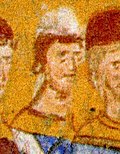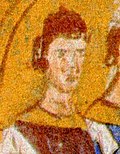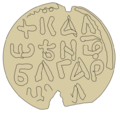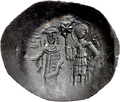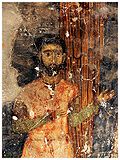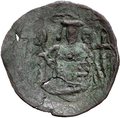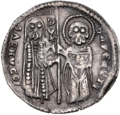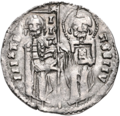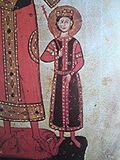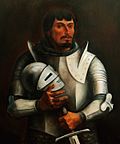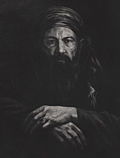Top Qs
Timeline
Chat
Perspective
List of Bulgarian monarchs
From Wikipedia, the free encyclopedia
Remove ads
The monarchs of Bulgaria ruled Bulgaria during the medieval First (c. 681–1018) and Second (1185–1422) Bulgarian empires, as well as during the modern Principality (1879–1908) and Kingdom (1908–1946) of Bulgaria. This list includes monarchs from the establishment of the First Bulgarian Empire until modern times, omitting earlier mythical rulers as well as rulers of separate states such as Old Great Bulgaria and Volga Bulgaria.
Various titles have been used by the rulers of Bulgaria. The only recorded title, used before Bulgaria's conversion to Christianity, is kanasubigi, likely meaning "Khan, Lord of the Army"[1] or "the sublime Khan".[2] When Bulgaria converted to Christianity in the ninth century, the ruler Boris I (852–889) was using the title knyaz (prince).[3] For much of its later history under the first and second empires, Bulgaria functioned as a multi-ethnic imperial state modelled on the neighbouring Byzantine Empire,[4] which contributed to the adoption of the title of tsar (emperor) by Bulgarian monarchs beginning with Simeon I (893–927) in 913.[5] Some powerful medieval Bulgarian rulers challenged Byzantine authority by proclaiming themselves as both Bulgarian and Roman emperors.[6]
When Bulgaria re-emerged as a state in 1878 in the form of the Principality of Bulgaria, the rulers initially used the title knyaz since they were autonomous vassals of the Ottoman Empire and not fully independent.[7] From Bulgaria's complete independence from the Ottomans in 1908 until the abolition of the monarchy in 1946, Bulgarian monarchs once more used the title tsar,[8] though this time generally translated internationally as "king" rather than "emperor".[8][9]
Remove ads
Titles
Summarize
Perspective
Titles in the First Bulgarian Empire (681–1018)

Evidence concerning the titles used by the rulers of the First Bulgarian Empire (681–1018) prior to the conversion to Christianity in the 860s is scant. The only title known from contemporary sources is kanasubigi, recorded in ten Greek-language inscriptions (as ΚΑΝΑΣΥΒΙΓΙ) from the ninth century in reference to Omurtag (814–831) and his son Malamir (831–836). Two gold medallions struck for Omurtag also use the same title.[10]
Upon his conversion to Christianity in 864/865, Boris I (852–889) adopted the new ruling title knyaz, generally translated as "prince" (though sometimes alternatively as "king").[3] This title was used by the Bulgarian rulers until 913, when the knyaz Simeon I (893–927), Boris I's son, invaded the Byzantine Empire. Simeon aspired to make Bulgaria into the new "universal monarchy" (a role the Byzantines viewed themselves as having) by absorbing and replacing the empire centered in Constantinople. Due to the threat presented by Simeon, who reached the walls of Constantinople, the Byzantines relented and the Patriarch of Constantinople, Nicholas Mystikos, granted him an imperial crown.[11] The only other monarch recognized as a basileus (i.e. emperor) by the Byzantines was (at times) the Holy Roman emperor.[12] The Byzantines did not consider Simeon as outranking their own emperors and designated him as the "Emperor of the Bulgarians". Simeon himself used the grander title "Emperor of the Bulgarians and the Romans".[11] The title of emperor was in Bulgarian translated as tsar (deriving from the Latin caesar), seen as equivalent to the Greek basileus or Latin imperator.[5]
Bulgarian rulers from the death of Simeon I in 927 until the fall of the First Bulgarian Empire in 1018 used the simpler "Emperor of the Bulgarians", ceasing to claim Byzantium's universal monarchy.[11]
Titles in the Second Bulgarian Empire (1185–1422)
The first rulers of the Second Bulgarian Empire (1185–1422) revived the style used by Simeon I's successors, "Emperor of the Bulgarians", rendered tsr’ Bl’garom in Bulgarian documents and imperator Bulgarorum in Latin.[13] The second empire's third ruler, Kaloyan (1196–1207), adopted the grander title "Emperor of Bulgarians and Vlachs" (imperator Bulgarorum et Blachorum).[14][15] He unsuccessfully sought recognition of this title from the Papacy, though Pope Innocent III merely recognized him as "King of the Bulgarians and Vlachs" (rex Bulgarorum et Blachorum), not wishing to recognize any other emperor than the Holy Roman emperor.[15]
The fifth ruler of the second empire, Ivan Asen II (1218–1241) after 1230 extended his original title "Emperor of the Bulgarians" to the grander "Emperor of the Bulgarians and Greeks" (tsr’ Bl’garom i Gr’kom, Latin: imperator Bulgarorum et Grecorum). This title was taken to reflect his extensive conquests in formerly Byzantine territory and was effectively a revival of Simeon I's title since both "Greeks" and "Romans" were envisioned as referring to the inhabitants of the Byzantine Empire.[6][13] Ivan Asen II also introduced the element "autocrat" (Bulgarian: samodrzac, Latin: moderator) into the Bulgarian imperial title, modelled on its usage in the Byzantine imperial title,[13] and eventually in full styled himself as the "Emperor and Autocrat of the Bulgarians and Greeks"[6][13] (Bulgarian: tsr’ i samodrzac Bl’garom i Gr’kom, Latin: imperator et moderator Bulgarorum et Grecorum).[13]
Ivan Asen II's successors kept "autocrat" in the title but returned to the simpler style "Emperor and Autocrat of the Bulgarians".[16] His extended title was later revived by Ivan Alexander (1331–1371), who also proclaimed himself as the "Emperor and Autocrat of the Bulgarians and Greeks"[16] to challenge the authority of the then weakened Byzantine Empire.[17] Ivan Alexander's son Ivan Shishman (1371–1395) is also recorded to have used this extended imperial title.[16]
Titles in modern Bulgaria (1878–1946)
The Tarnovo Constitution of the modern Principality of Bulgaria (1878–1908) stipulated that the monarch was to use the title "Knyaz of Bulgaria" (i.e. "Prince of Bulgaria") rather than tsar due to the principality being an autonomous vassal state of the Ottoman Empire rather than a fully independent country.[7]
When Bulgaria achieved complete independence from the Ottoman Empire in 1908, the former knyaz Ferdinand I (1887–1918) adopted the higher title of "Tsar of the Bulgarians", as had been used by Bulgarian monarchs in the Middle Ages. The assumption of the title of tsar was met with opposition from both the Ottomans and the Russian Empire.[8] Although tsar had been understood as equivalent to emperor in medieval times,[5] the title of the new Bulgarian tsars was generally translated as "King of the Bulgarians" internationally.[9]
Remove ads
Names and regnal numbers
Summarize
Perspective

Regnal numbers for monarchs have only been officially used in Bulgaria in modern times, beginning with Alexander I in 1879.[18] Modern historiography retroactively also assigns sequential regnal numbers to medieval Bulgarian rulers, even if they ruled different Bulgarian states and used different titles; Boris I (852–889) ruled the First Bulgarian Empire as a prince (knyaz), his great-grandson Boris II (967–977) ruled the same state as emperor, and Boris III (1918–1943) ruled the modern Kingdom of Bulgaria as tsar (king).[18]
There were three different types of names used by medieval Bulgarian monarchs after Bulgaria converted to Christianity; names drawn from Bulgar or Slavic tradition (i.e. Boris, Boril, Vladimir, Presian), names drawn from Christian tradition (i.e. Michael, Simeon, Peter, Ivan, Samuel), or double names combining both (i.e. Ivan Vladislav, Gavril Radomir, Ivan Sratsimir, Theodore Svetoslav). When using a double name, the Christian name always preceded the name drawn from local tradition. Very rarely, Bulgarian rulers used double names combining two Christian names (i.e. Ivan Stephen, Ivan Alexander).[18]
The use of double names by Bulgarian monarchs, sometimes not used consistently in contemporary sources,[a] has in cases led to confusion and misunderstanding in modern efforts to assign regnal numbers. In particular, it has sometimes erroneously been assumed that the usage of double names indicated that the monarchs employed family names; this interpretation has in the past resulted in the use of names such as Ivan II Asen (for Ivan Asen II), George I Terter (for George Terter I) and Michael III Shishman (for Michael Asen III). Names of clans were prominently used in Bulgaria in pre-Christian times, though disappeared from usage sometime after the conversion to Christianity, despite family names being used in some of Bulgaria's closest neighbours (such as the Byzantine Empire).[18] Although names such as Asen or Terter could serve as genealogical and political markers to demonstrate a ruler's position in an illustrious lineage they were also fully part of the ruler's regnal names, as demonstrated by those rulers whose double names excluded genealogical connections (such as Ivan Alexander). Double names with genealogical connotations were at times also claimed by rulers not belonging to the same dynastic lineage, such as Mitso Asen (1256–1257; who married into the Asen dynasty).[18]
Remove ads
First Bulgarian Empire (c. 680–1018)
Summarize
Perspective
Early Bulgarian rulers (c. 680–803)
The First Bulgarian Empire is regarded to have been established c. 680 when the Bulgarian ruler Asparuh crossed the Danube.[19][20] Asparuh's family, the Dulo clan, claimed descent from the Hunnic ruler Attila, through Attila's son Ernak.[19] References to political developments within Bulgaria prior to the reign of Krum (c. 803–814) are extremely scant, making the dates and family relationships of the rulers recorded in contemporary and later sources highly uncertain.[21] The rulers below may all belong to the Dulo clan or might alternatively have belonged to various competing clans.[21] Several alternate chronologies of early Bulgarian rulers have been proposed, with some presented below, with the names standardized across sources:
House of Krum (803–997)
House of Cometopuli (997–1018)
Remove ads
Pretenders during Byzantine rule (1018–1185)
Summarize
Perspective
Various Byzantine military governors (with the title strategos) were appointed in formerly Bulgarian lands over the course of the Byzantine conquest of Bulgaria, from the 970s onwards.[47] Following the completion of the conquest of Bulgaria in 1018, Emperor Basil II organized much of the central Balkans into the Theme of Bulgaria, which was governed by an imperially appointed official titled (depending on the time) as the doux (duke) or katepano of Bulgaria.[47][48] The capital of Byzantine Bulgaria was Skopion (modern-day Skopje).[47][48] There were several attempts at restoring the Bulgarian Empire during the nearly two centuries of Byzantine rule.
Remove ads
Second Bulgarian Empire (1185–1422)
Summarize
Perspective
House of Asen (1185–1256)
Successors of the Asenids (1256–1280)
The end of the male line of the House of Asen plunged Bulgaria into a chaotic period of fragmentation and civil wars between numerous lines of claimants.[56]
House of Terter (1280–1292, first time)
House of Smilets (1292–1299)
House of Borjigin (1299–1300)
House of Terter (1300–1323, second time)
House of Shishman (1323–1331)
House of Sratsimir (1331–1422)
The rulers of the House of Sratsimir, patrilineal descendants of the despot Sratsimir, are in lists of monarchs often designated as part of the Shishmanid dynasty, with which they only share matrilineal descent. Through their matrilineal descent from the House of Shishman, the rulers of the House of Sratsimir were also descendants of the House of Asen.[18]
Remove ads
Pretenders during Ottoman rule (1422–1878)
Summarize
Perspective
Following the gradual conquest of Bulgaria in the 14th and 15th centuries, the Ottomans incorporated the Bulgarian lands into the vast province of Rumelia.[66] In the late 16th century, the new province of Silistra was created due to persistent northern attacks from the Cossacks.[66] Later on, much of modern-day northern Bulgaria was organized into the Danube vilayet, which in terms of borders closely corresponded to the succeeding autonomous Principality of Bulgaria.[67] Like under the period of Byzantine rule, the Ottoman authorities were sometimes faced with Bulgarian uprisings aimed at independence, at times also involving the proclamation of new Bulgarian monarchs.
Remove ads
Principality (1878–1908) and Kingdom of Bulgaria (1908–1946)
House of Battenberg (1879–1886)
House of Saxe-Coburg and Gotha (1887–1946)
Remove ads
Family trees
Remove ads
See also
Notes
- Monarchs with double names are in formal contexts most often recorded with both names. Ivan Asen II (1218–1241) is sometimes recorded merely using his second name (Asen). His sons Kaliman Asen I (1241–1246) and Michael Asen I (1246–1256) are sometimes recorded to only use their first names (Kaliman, Michael). Similarly, George Terter I (1280–1292) is in at least one contemporary source referred to merely as George. In most official documents, Ivan Alexander (1331–1371) and his sons Ivan Sratsimir (1356–1397) and Ivan Shishman (1371–1395) are referred to with their full double names, but in less formal contexts they are sometimes referred to merely by their more characteristic second names (Alexander, Sratsimir, and Shishman).[18]
- Enumerated as Peter IV if the rebels Peter Delyan (Peter II) and Constantine Bodin (Peter III) are also counted.[18]
- The House of Asen has in the past sometimes been suggested to have descended from the monarchs of the First Bulgarian Empire given that Kaloyan (1196–1207) was identified by Pope Innocent III (1198–1216) in a letter as descended from them. This is conventionally interpreted as the pope merely recognizing Kaloyan as the legitimate successor (and not a genealogical descendant) of the earlier tsars, in a way common for the time.[54]
- In his formal titulature, Kaloyan referred to himself by the name Kaloyan (rendered in Latin as Calojoannes).[16] He is additionally counted as "Ivan I" since Ivan (without a double name) was his original name; "Kaloyan" derives from the Greek Kaloïōannēs and is an ornate and flattering nickname meaning "John [Ivan] the Good".[18]
- Often referred to as Michael II Asen, although this is incorrect. This enumeration derives from Boris I (852–889) having been baptized under the name Michael. Boris I however continued to most often merely use "Boris" and the emperors of the Second Bulgarian Empire used the double name Michael Asen (Asen being part of the name and not some other form of qualifier) rather than just "Michael".[18]
- It is doubtful that Ivaylo was this ruler's real name given that the only medieval source using it (the Svrljig gospels) might instead be informally referring to his successor Ivan Asen III. The only other names applied to him in medieval sources are the Greek nicknames Lakhanas and Kordokoubas, attested in Byzantine sources.[18]
- Sometimes referred to as Ivan IV Smilets, numbered after Ivan Asen I–III (then considered Ivan I–III) and not counting Kaloyan as Ivan I nor counting Ivan Vladislav. The rulers named Ivan Asen however used that name as a double name and are more appropriately numbered as such; Ivan Vladislav also used a double name. The combination Ivan Smilets for this ruler is modern and does not occur in any contemporary sources.[18]
- Many sources erroneously refer to this emperor as Michael III Shishman. His regnal name, attested in both Bulgarian and Byzantine sources, was the double name Michael Asen. The designation "Michael Shishman" (which connects him to his father Shishman of Vidin) is not attested in contemporary sources.[18]
- All known contemporary documents refer to Constantine II merely by the name Constantine. It is possible that he (like Constantine I) used the double name Constantine Asen, especially given that Asen was incorporated into the double names of three of his uncles. None of the surviving documents are from Constantine's chancery and no known seals or charters exist, making it impossible to confirm this hypothesis.[18]
- Enumerated after Ivan Shishman (1371–1395). He is sometimes alternatively referred to as Shishman II,[69] or (also counting Shishman of Vidin, who did not reign as tsar) as Ivan Shishman III[70] or Shishman III.[71]
- Alexander I was not the only choice proposed for the first modern Bulgarian monarch. The Russian prince Alexander Mikhailovich Dondukov-Korsakov (1820–1893), who headed the Russian administration in Bulgaria at the time, put himself forth for the position though was rejected. The Congress of Berlin decided that no Russian or Bulgarian should be allowed to become Prince of Bulgaria.[74] In addition to Alexander, other European royalty considered included Prince Valdemar of Denmark, Prince Henry XXV of Reuss, and Prince Carol of Romania.[74] Alexander was ultimately selected by the Bulgarian parliament due to having served in the Russo-Turkish War, his close relationship with (and endorsement by) Alexander II of Russia, and his known conservative political stance.[74]
- After the conclusion of World War II, royalists and nationalists began to hail Boris as a "rescuer of the Bulgarian Jews", though scholars consider this a dubious honour.[81] Under Boris III's regime, thousands of Jews were deported to Germany from Bulgarian-occupied lands in Thrace and Macedonia,[81] resulting in 11,343 deaths.[80] It was further intended to also deport the Jews of Bulgaria proper, though the regime abandoned these plans following intense public outcry.[81] 48,000 Jews of Bulgaria's pre-war territory consequently survived the Holocaust,[80][81] though were subjected to other forms of discrimination, including being forbidden from holding public office,[78] forcible internal deportation, and dispossession.[80] Bulgaria was the only country to sign a written agreement "to supply Jews to Germany".[78] Romani people were also subject to discrimination, being forced to register for forced labor and being barred from marrying Bulgarians.[78]
- Omitting earlier monarchs since their family relationships are too uncertain to construct a family tree
Remove ads
References
Wikiwand - on
Seamless Wikipedia browsing. On steroids.
Remove ads












